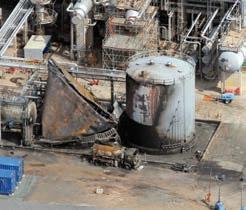
5 minute read
NEWS
Update
WHAT YOU NEED TO KNOW THIS ISSUE
IN THIS SECTION
Latest from UK government on new Building Safety Regulator and Fire Safety Bill P7 | UK HSE issues report on 2011 Pembroke refi nery explosion P8 | The risks and benefi ts of being a ‘gig’ worker P8 | Reclassifi cation of welding fume leads to safety blitz P8 | Driver death toll mounts on smart motorways P9 | Dates for your diary: must-attend events for OSH practitioners P9
FIRE SAFETY
New Building Regulator delayed
he new Building Safety Regulator being established by the UK Health and Safety Executive (HSE) in the wake of the failings uncovered by the Grenfell Tower fi re is not likely to be up and running until 2021, the UK government has admitted.
The scope of projects covered by the regulator is also likely to be T
wider than originally thought.
A spokesperson for the Ministry of Housing, Communities and Local Government told IOSH magazine that although the board, headed up by former HSE chair Dame Judith Hackitt, met for the fi rst time in midFebruary, the new regulator won’t be fully established until the Fire Safety Bill has been enacted, which the government aims to do ‘as soon as possible’ to implement the legislative recommendations of the Grenfell Tower public inquiry phase 1 report.
The fi rst phase of the inquiry, chaired by Sir Martin Moore-Bick, highlighted ‘serious shortcomings’ in the London Fire Brigade’s preparedness for and response to the June 2017 inferno that killed 72 people.
MAJOR HAZARDS Failings behind fatal refi nery explosion
he UK Health and Safety Executive (HSE) has released its longawaited report on the safety failings that led to an explosion at Chevron’s Pembrokeshire refi nery in south Wales in 2011. The report reveals the underlying causes of the incident, which killed four people and seriously injured one other.
Shortly after the explosion, the HSE issued a safety alert to inform industry of the preventative measures required to avert a similar occurrence. A complex investigation followed, and the new report is intended to inform those in major hazard industries of what went wrong, and apply lessons to their own organisations Although a number of years have elapsed since the incident, the information contained within the report remains highly relevant today, the HSE confi rmed. T

bit.ly/HSE-pembroke
Pros and cons of the gig economy
With the rise in self-employment, independent contractors, and workers accessing labour markets online, the world of work is undergoing rapid change, with up to 2.8 million gig workers in the UK.
In response, the UK HSE has published new research on the risks and benefi ts of the growing ‘gig’ economy to inform future OSH policy.
RISKS
Time pressures Mental health problems Work-related stress No sick pay Lack of control Musculoskeletal disorders Social isolation No maximum driving time Fatigue Poorer health outcomes. 2.8m The estimated number of gig economy workers in the UK

BENEFITS
Independence Self-employment Options Flexibility Informality Variety Work/life balance Opportunities for the disadvantaged.
COSHH
SAFETY BLITZ: WELDING FUME
WHAT HAS BEEN LAUNCHED? The UK HSE has warned it will be carrying out inspections to ensure employers are protecting their workers’ health by controlling the risks from welding fume.
WHAT SHOULD ORGANISATIONS BE DOING? Employers must ensure they have adequate controls in place to avoid or reduce exposure to welding fume. They should use local exhaust ventilation where effective and provide suitable respiratory protective equipment where necessary to protect workers in the metal fabrication industry from inhaling fume.
HOW DID THIS COME ABOUT? New evidence last year showed exposure to mild steel welding fume can cause cancer, and the HSE updated its guidance. As a result of the International Agency for Research on Cancer releasing evidence that exposure to mild steel welding fume can cause lung cancer and possibly kidney cancer in humans, mild steel welding fume was reclassifi ed as a human carcinogen by the Workplace Health Expert Committee in February 2019.
WHAT ARE THE IMPLICATIONS? OSH content developer Michael Edwards, who represents IOSH on the Industry and Regulatory Forum on Local Exhaust Ventilation, said: ‘Further efforts must be made
to protect workers involved in
welding as part of their roles. ‘IOSH urges employers in the UK to review current
welding control measures to ascertain that they meet these raised control standards.’

ROAD SAFETY
Killer motorways?
o-called ‘smart’ motorways hit the headlines recently after the BBC’s Panorama programme questioned how safe they really are.
Smart motorways, where the hard shoulder is turned into a live lane, have been criticised because refuge areas are spaced too far apart and drivers who break down can be trapped in speeding traffi c. According to a Freedom of Information request by the BBC to Highways England, 38 people have died on smart motorways in the past fi ve years. It is the fi rst time that the total number of deaths has been reported. The idea behind smart motorways was to improve the fl ow of traffi c through the most congested parts of the network by using the hard shoulder as an extra lane. But some breakdown organisations have instructed roadside technicians not to stop on smart motorways amid increasing safety concerns after it was revealed a number of workers died last year.
Transport secretary Grant Shapps has announced he wants to fi x smart motorways because they are too confusing for drivers.
A government review, the results of which are due to be announced shortly, is expected to recommend reforms to improve road safety. On smart motorways, refuge areas are too far apart and drivers who break down can be trapped in speeding traffi c S
DATES FOR YOUR DIARY
10-11 MARCH Health and Wellbeing at Work BIRMINGHAM
What will be covered? Positive psychology coaching Autism in the workplace GDPR Whistleblowing Staff surveillance
bit.ly/hww-2020
25-26 MARCH Future of Gas III BIRMINGHAM
Hosted by the HSE, this event will look at decarbonisation and the challenge of regulating this growing area of new technology.
bit.ly/future-gas
1 APRIL
South Wales Safety Groups Alliance Annual Conference and Exhibition CARDIFF
Sessions will include: Proportionate OSH (keynote address) Occupational cancer Respiratory disease Musculoskeletal disorders Mental health fi rst aid.
bit.ly/sww-2020
20-23 APRIL Occupational Hygiene 2020 BRISTOL
The BOHS Annual Conference will bring together researchers, practitioners and regulators from around the world to discuss the issues affecting those working in occupational hygiene.
bit.ly/oh-2020
28 APRIL RoSPA Scotland Conference 2020 EDINBURGH
Conference for the OSH community in Scotland to discuss key issues, as well as a range of case studies and interactive sessions.
bit.ly/rospa-2020
28-30 APRIL
The Health and Safety Event 2020 BIRMINGHAM
This three-day event attracts more than 16,000 workplace professionals to attend a range of seminars, practical workshops and an exhibition hall offering the latest products and services.
bit.ly/hase-2020









